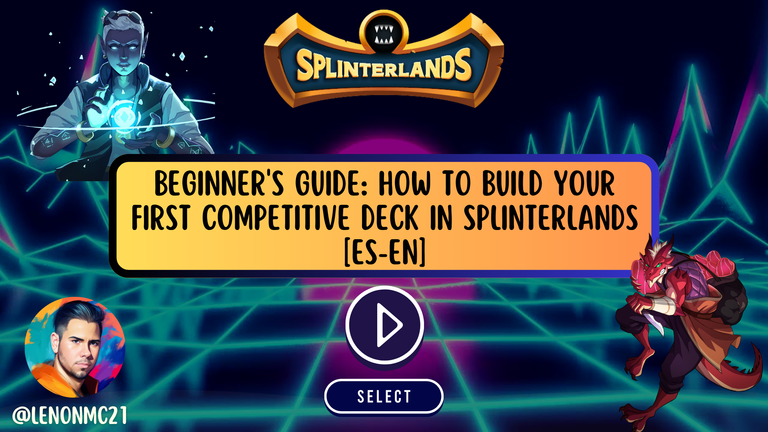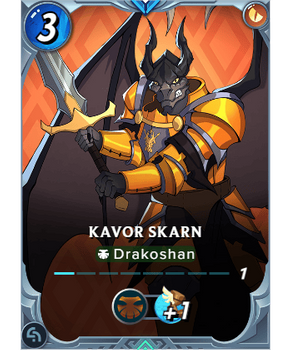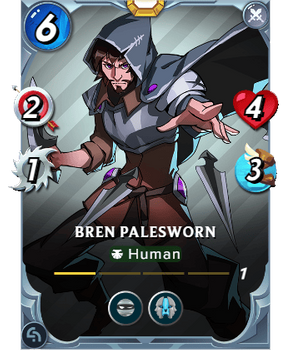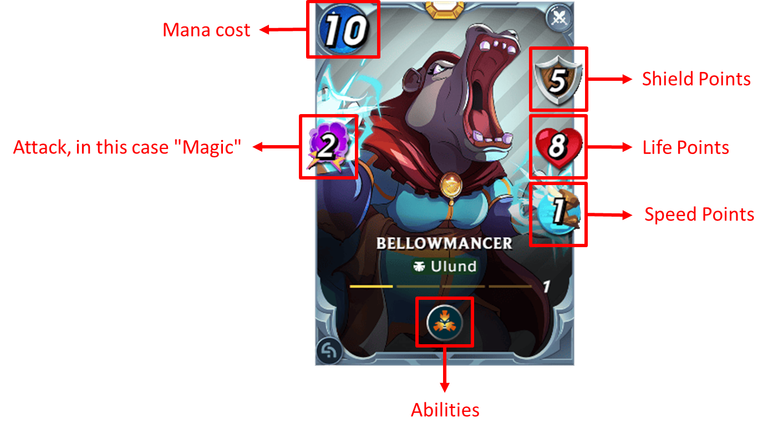Beginner's Guide: How to build your first competitive deck in Splinterlands [ES-EN]

Cover created in Canva

Se que esto suena a mucho “Cliché” y siendo realista es cierto, pero, la verdad es que me parece que no tengo una guía bien estructurada para principiantes que los nuevos jugadores puedan usar y/o leer para conocer sobre el juego, o más bien como jugarlo, porque los aspectos de inversión o económicos vendrían siendo otro tema muy aparte de lo que es la jugabilidad, aunque, de cierta forma todo se combina o engrana para que pueda funcionar, ya que por ejemplo, sin una inversión, básicamente no puedes generar recompensas, aunque, en la actualidad, ya esto no es del todo cierto, pero, también es un tema muy distinto.
En todo caso, hoy quiero comenzar con lo que será una “Guía” oficial para principiantes, donde podrán conseguir absolutamente todo sobre el juego, aunque cuando digo todo, me refiero a información de como iniciar, más que todo enfocado en la “Jugabilidad”, aunque no se preocupen, planeo realizar una “Guía de inversión y economía en el juego”, pero, comencemos por lo básico, sin abrumar a los nuevos jugadores, ya que, lo que nos interesa, o al menos como yo lo veo, es que vengan a divertirse, ganen algunas recompensas y posteriormente pasen al resto de las etapas, como la inversión, la economía, los tokens, multiplicadores etc.
Así que, te doy la bienvenida a esta 1ra parte de la “Guía para “Principiantes” en donde te enseñare todo lo que necesitas saber para construir tu primer mazo competitivo en “Splinterlands”, por supuesto, con algunos detalles (Estrategias) sobre como jugar, así que, sigue leyendo y cualquier duda, dejen sus comentarios:

¿Qué son los “Fundamentos del Mazo?

Una definición bastante peculiar que me he inventado justo ahora al momento de escribir este post, pero que engrana perfectamente con lo que quiero explicar, ya que sin estas bases no podrán entender todo lo que viene luego, ademas, los mazos en “Splinterlands” no son solo cartas al azar, se trata de aprender una estrategia con algunos elementos claves que debes de saber antes de elegir que cartas jugaras en una batalla, por lo que, para que me entiendas mejor, vamos a definir estos elemento clave:

Elementos clave
Arconte (Antes llamado Invocador):

El Arconte o Invocador viene siendo como el líder de tus tropas o e este caso, tu “Mazo” de cartas, por lo que, para ganar una batalla debes elegir sabiamente con quien y cuando jugarlo, básicamente, el “Arconte” determina que “Splinters-Elementos o Lineas de Sangre” puedes jugar, los elementos en el juego son (Fuego, Agua, Tierra, Vida, Muerte, Dragón y Neutral), con respecto a las “Lineas de Sangre”, son muchas y creo que esto merece su propia publicación, pero, lo que quiero que aprenda, es la importancia del “Arconte”, sin ellos, no podremos jugar, por lo que, esto es fundamental para armar nuestro mazo.
Unidades (Cartas de Monstruo):

Siguen prácticamente la misma esencia que los “Arcontes”, pero, son de cierta manera diferentes, ya que existentes distintos tipos, separados bien sea por su splinter o elemento, sino también por las líneas de sangre, cada una con sus propias estadísticas (Ataque, Velocidad, Escudo, Vida y Costo de mana), por supuesto y algo muy importante son sus “Habilidades”, las cuales nos sirven para que nuestras cartas tengan determinados usos en el campo de batalla, lo que básicamente nos brinda la posibilidad de crear estrategias de diferentes tipos.
Reglas de batalla:

Con esto cerramos el tridente de los fundamentos del “Mazo”, y es que las reglas de la batalla se establecen antes de cada batalla, las cuales pueden cambiar de forma radical el desarrollo de una batalla, estas reglas en su mayoría se derivan de las habilidades existentes en el juego, si, esas que ya mencione que tienen las cartas, pues, adaptarnos a estas reglas es tan importante como las cartas en sí mismas, y pueden influir si ganamos o perdemos la contienda, así que, hay que prestarle atención.

Desglosando las cartas para conocer el lenguaje de la batalla

Las cartas son el “Pilar” de Splinterlands, digo esto con mucha propiedad ya que sin ellas no pudiéramos jugar, y la esencia de este no existiría, por lo que, para dominar la jugabilidad, debes saber qué es lo que hace cada carta, por lo que, a continuación, te presento las “Estadísticas” que encontraras en todas las cartas del juego, o mayormente las que se llaman “Unidades o Monstruos”:

- Puntos de mana (Costo de mana): Este es un número que podemos ver en la parte superior izquierda de cualquier carta en el juego, incluidos los “Arcontes”, este número determina el coste que debemos cubrir para invocador una carta al campo de batalla, ya que, en cada batalla, antes de que inicie en conjunto con las reglas que ya mencione, también podremos ver el límite de puntos de mana de cada partida, un aspecto clave para la construcción de un mazo.
Puntos de Ataque: Existen 3 tipos de ataque en el juego que son: Cuerpo a Cuerpo, A distancia o de Rango, y el Mágico. Cada una actúa de forma distinta cuando está en el campo de batalla, por ejemplo, el cuerpo a cuerpo es físico, y originalmente solo ataca cuando la carta está en la 1ra posición, el de rango, ataca desde cualquier posición, menos la primera, y el mágico, uno de mis favoritos, ignora el escudo y va directamente a los puntos de vida, ademas, ataca desde cualquier posición.
Velocidad: Estos puntos determinar el orden con que las cartas atacaran, mientras más alto sea, más rápido atacara, ademas, esta es una pieza clave también para estrategias, sin mencionar que, también para la defensa, ya que, si una carta con baja velocidad ataca a una con una muy alta, probablemente el ataque falle.
Escudo y Vida: El escudo es literalmente una estadística que funciona como un muro antes de afectar los puntos de vida de una carta, por ejemplo, los monstruos de ataque físico y a distancia antes de llegar a los puntos de vida, deben de destruir el escudo y su puntaje, que es básicamente la característica “Defensiva” más importante en una estrategia. Ahora los puntos de vida determinan cuando una carta muere o continua en el campo, si estos disminuyen a cero, la carta desaparecerá.

La línea de frente y la “Retaguardia
Aquí seré más breve porque el post se está haciendo muy largo, básicamente cuando hablo de “Línea de Frente y Retaguardia” me refiero a las posiciones de las cartas en el campo de batalla y la función y el tipo de cartas con las que hay que jugar en cada una de ellas, pero, hablando de forma básica, las líneas y/o posiciones deben de gestionarse así:
Posición 1 (El Tanque): Básicamente esta vendría siendo la posición más importante en el campo de batalla, ya que por lo general esta es la carta que servirá como “Defensa” del resto, las cualidades que debe de tener son sencillas: Mucha vida y escudo y preferiblemente con un ataque físico cuerpo a cuerpo, con el fin de que tenga “Resistencia” y adicional pueda hacer el suficiente daño, ya que deberá ser lo más fuerte que se pueda.
Posición del 2 al 6 (Daño y Soporte): En el resto de las posiciones debemos jugar con cartas que se enfoquen primeramente en hacer daño a distancia, para eso tenemos a los tipos de ataque “Mágicos y de Rango”, por otro lado, en posiciones estratégicas, entre la posición 3 y 6, podríamos también incluir una carta de “Soporte”, con esto me refiero a una carta que “Cure” vida o escudo o ambas, por ejemplo, todo esto mientras el tanque protege la combinación.
Nota: Esto particularmente lo explicare en un post aparte en detalle, así que no se preocupen.

Consideraciones finales

Con todo esto es más que suficiente para terminar la 1ra parte de lo que es la “Guía para Principiantes” que construiré, y que he comenzado en cómo construir un mazo competitivo básico para cualquier tipo de jugador, si bien hay algunos detalles que me puse pasar por alto, no quiero hacer estas publicaciones tan largas, ya que pueden ser pesadas para la lectura.
Por lo que, cualquier duda que tengan sobre este tema, no duden en comentar, vendrán muchas más partes de esta guía.
Nos vemos en el "Campo de Batalla"

I know this sounds very cliché, and realistically it's true, but the truth is that I don't think there is a well-structured guide for beginners that new players can use and/or read to learn about the game, or rather how to play it, because the investment or economic aspects would be another topic quite separate from gameplay, although, in a way, everything combines or meshes together to make it work. For example, without an investment, you basically can't generate rewards, although, nowadays, this is no longer entirely true, but that's also a very different topic.
In any case, today I want to start with what will be an official "Guide" for beginners, where you can find absolutely everything about the game. When I say everything, I mean information on how to get started, focusing mainly on "Gameplay." But don't worry, I plan to create a "Guide to investment and economics in the game." But let's start with the basics, without overwhelming new players, because what we're interested in, or at least how I see it, is that they come to have fun, earn some rewards, and then move on to the rest of the stages, such as investment, economics, tokens, multipliers, etc.
So, welcome to this first part of the "Beginner's Guide," where I will teach you everything you need to know to build your first competitive deck in Splinterlands, including some details (strategies) on how to play. Keep reading, and if you have any questions, leave your comments below.

What are the "Fundamentals of the Deck"?

A rather peculiar definition that I just made up while writing this post, but one that fits perfectly with what I want to explain, since without these basics you won't be able to understand everything that comes next. Furthermore, decks in Splinterlands are not just random cards; it's about learning a strategy with some key elements that you need to know before choosing which cards to play in a battle. So, to help you understand better, let's define these key elements:

Key elements
Archon (formerly known as Summoner):

The Archon or Summoner is like the leader of your troops or, in this case, your "deck" of cards, so to win a battle you must choose wisely who to play with and when to play them. Basically, the "Archon" determines which "Splinters-Elements or Bloodlines" you can play. The elements in the game are (Fire, Water, Earth, Life, Death, Dragon, and Neutral). As for the "Bloodlines," there are many, and I think this deserves its own post, but what I want you to learn is the importance of the "Archon." Without them, we cannot play, so this is essential for building our deck.
Units (Monster Cards):

They follow practically the same essence as the "Archons," but they are somewhat different, as there are different types, separated either by their splinter or element, but also by bloodlines, each with its own stats (Attack, Speed, Shield, Health, and Mana Cost). Of course, something very important is their "Abilities," which allow our cards to have specific uses on the battlefield, basically giving us the possibility to create different types of strategies.
Rules of battle:

This concludes the three fundamental aspects of the "Deck." and that is that the rules of battle are established before each battle, which can radically change the course of a battle. These rules are mostly derived from the existing abilities in the game, yes, those that I already mentioned that the cards have. Adapting to these rules is as important as the cards themselves, and they can influence whether we win or lose the battle, so we must pay attention to them.

Breaking down the cards to understand the language of battle

Cards are the "cornerstone" of Splinterlands. I say this with great certainty because without them we couldn't play, and the essence of the game would not exist. Therefore, to master the gameplay, you must know what each card does. Below, I present the "Statistics" that you will find on all the cards in the game, or mostly those called "Units or Monsters":

- Mana points (Mana cost): This is a number that we can see in the upper left corner of any card in the game, including the "Archons." This number determines the cost we must pay to summon a card to the battlefield. In each battle, before it begins, along with the rules I already mentioned, we can also see the mana point limit for each game, which is a key aspect of deck building.
Points of Attack: There are three types of attacks in the game: Melee, Ranged, and Magic. Each one acts differently on the battlefield. For example, melee is physical and originally only attacks when the card is in the first position, ranged attacks from any position except the first, and magic, one of my favorites, ignores the shield and goes directly to the health points, and also attacks from any position.
Speed: These points determine the order in which the cards will attack. The higher the point, the faster the attack. This is also a key factor in strategy, not to mention defense, since if a card with low speed attacks one with very high speed, the attack will likely fail.
Shield and Life: The shield is literally a statistic that acts as a wall before affecting a card's health points. For example, physical and ranged attack monsters must destroy the shield and its score before reaching the health points, which is basically the most important "Defensive" feature in a strategy. Now, health points determine when a card dies or remains on the field. If they decrease to zero, the card will disappear.

The front line and the rear guard
I'll be brief here because this post is getting very long. Basically, when I talk about "Front Line and Rear Guard," I'm referring to the positions of the cards on the battlefield and the function and type of cards that must be played in each of them. But, speaking in basic terms, the lines and/or positions should be managed as follows:
Position 1 (The Tank): Basically, this would be the most important position on the battlefield, since this is usually the card that will serve as "Defense" for the rest. The qualities it must have are simple: lots of life and shield, and preferably with a physical melee attack, so that it has "Resistance" and can also do enough damage, since it must be as strong as possible.
Positions 2 to 6 (Damage and Support): In the remaining positions, we should play cards that focus primarily on dealing damage from a distance. For this, we have the "Magic and Range" attack types. On the other hand, in strategic positions, between positions 3 and 6, we could also include a "Support" card. By this, I mean a card that "Heals" life or shield or both, for example. all this while the tank protects the combination.
Note: I will explain this in detail in a separate post, so don't worry.

Final thoughts

All of this is more than enough to finish the first part of the "Beginner's Guide" that I am putting together, which I started with how to build a basic competitive deck for any type of player. Although there are some details that I overlooked, I don't want to make these posts too long, as they can be tedious to read.
So, if you have any questions about this topic, please feel free to comment. There will be many more parts to this guide.
See you at the "Battlefield".

Here is the direct link to my latest posts and the link to my Profile
Visit my website
| https://files.peakd.com/file/peakd-hive/lenonmc21/23xp8UEvA1pDUEZaiaRE9C9s959ZUiUXFvV3JxKFDuNNQB2eANCCHWrB7yLEZKCRgSSeu.png | https://files.peakd.com/file/peakd-hive/lenonmc21/23wMhBiXr1sDDngz2wtkF9kT31ed5UuwPwPFNNskV17Er2j12mhirm5r4efpfbzgBoeW4.png |
| Estrategias adaptativas pata jugar en el nuevo “Formato Frontier” (Parte 1 Teórica) [ES-EN] | Te muestro todo lo que tienes que saber para jugar en el nuevo “Formato” gratuito de Splinterlands llamado “Frontier” [ES-EN] |



If you are new, I invite you to register in this LINK


Proud Member of "Shield of Glory".

Posted Using INLEO

Thanks for sharing! - @isaria
